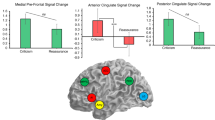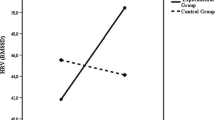Abstract
Heart rate variability (HRV) is considered an index of self-regulatory capacity, and trait compassion predicts healthy HRV and self-regulation. Compassion focused psychotherapy interventions have been shown to increase levels of compassion in the general population but no studies to date have examined if these interventions also increase HRV in a distressed clinical sample. The present study examined whether a 12-week compassion focused therapy intervention administered in group format would improve resting HRV and impact HRV reactivity during self-critical writing and self-compassion writing tasks administered before and after the intervention. A total of 31 participants in a university counseling center completed the intervention and HRV assessments. Resting HRV did not significantly change over the course of the intervention in the overall sample. Only those who showed a reliable increase in self-compassion also had a significant increase in resting HRV post-intervention. Additionally, the self-critical writing task was associated with a significant decrease in HRV, with HRV staying low during self-compassionate writing and then significantly increasing during recovery. Reliable change in self-compassion predicted increased HRV reactivity to self-critical and self-compassion writing tasks following the intervention, indicating greater engagement with the task. Findings support the idea that increased self-compassion increases HRV reactivity and potentially strengthens ability to engage with difficult emotions in psychotherapy.


Similar content being viewed by others
References
Adler, J. M., & Hershfield, H. E. (2012). Mixed emotional experience is associated with and precedes improvements in psychological well-being. PLoS ONE, 7, 1–10. https://doi.org/10.1371/journal.pone.0035633.
Baldwin, S., Bandarian-Balooch, S., & Adams, R. (2019). Attachment and compassion-threat: Influence of a secure attachment-prime. Psychology and Psychotherapy. https://doi.org/10.1111/papt.12244.
Balzarotti, S., Biassoni, F., Colombo, B., & Ciceri, M. R. (2017). Cardiac vagal control as a marker of emotion in healthy adults: A review. Biological Psychology, 130, 54–66. https://doi.org/10.1016/j.biopsycho.2017.10.008.
Berntson, G. G., Norman, G. J., Hawkley, L. C., & Cacioppo, J. T. (2008). Cardiac autonomic balance versus cardiac regulatory capacity. Psychophysiology, 45, 643–652.
Caldwell, Y. T., & Steffen, P. R. (2018). Adding HRV biofeedback to psychotherapy increases heart rate variability and improves the treatment of major depressive disorder. International Journal of Psychophysiology, 131, 96–101. https://doi.org/10.1016/j.ijpsycho.2018.01.001.
Collins, N. L., & Read, S. J. (1990). Adult attachment, working models, and relationship quality in dating couples. Journal of Personality and Social Psychology, 58, 644–663.
Cosley, B. J., McCoy, S. K., Saslow, L. R., & Epel, E. S. (2010). Is compassion for others stress buffering? Consequences of compassion and social support for physiological reactivity to stress. Journal of Experimental Social Psychology, 46, 816–823.
Duarte, J., McEwan, K., Barnes, C., Gilbert, P., & Maratos, F. A. (2015). Do therapeutic imagery practices affect physiological and emotional indicators of threat in high self-critics? Psychology and Psychotherapy: Theory, Research and Practice, 88, 270–284. https://doi.org/10.1111/papt.12043.
Elliott, C. H., & Lassen, M. K. (1997). A schema polarity model for case conceptualization, intervention, and research. Clinical Psychology: Science and Practice, 4, 12–28. https://doi.org/10.1111/j.14682850.1997.tb00095.x.
Gilbert, P., Catarino, F., Duarte, C., Matos, M., Kolts, R., Stubbs, J., et al. (2017). The development of compassionate engagement and action scales for self and others. Journal of Compassionate Health Care, 4(4), 1–24. https://doi.org/10.1186/s40639-017-0033-3.
Gilbert, P., Clarke, M., Kempel, S., Miles, J. N. V., & Irons, C. (2004). Criticizing and reassuring oneself: An exploration of forms style and reasons in female students. British Journal of Clinical Psychology, 43, 31–50.
Gilbert, P. (2007). Psychotherapy and counselling for depression (3rd ed.). London, England: Sage.
Gilbert, P. (2017). Compassion focused group therapy for college counseling centers. Derby, UK: Compassionate Mind Foundation.
Gilbert, P., McEwan, K., Matos, M., & Rivis, A. (2011). Fears of compassion: Development of three self-report measures. Psychology and Psychotherapy, 84(3), 239–255.
Hayes, S. C., Strosahl, K. D., & Wilson, K. G. (2011). Acceptance and commitment therapy, second edition: The process and practice of mindful change. New York: Guilford Press.
Hershfield, H. E., Scheibe, H. E., Sims, T. L., & Carstensen, L. L. (2013). When feeling bad can be good: Mixed emotions benefit physical health across adulthood. Social Psychological and Personality Science, 4, 54–61.
Holzman, J. B., & Bridgett, D. J. (2017). Heart rate variability indices as bio-markers of top-down self-regulatory mechanisms: A meta-analytic review. Neuroscience and Biobehavioral Reviews, 74, 233–255. https://doi.org/10.1016/j.neubiorev.2016.12.032.
Jain, F., Cook, I., Leuchter, A., Hunter, A., Davydov, D., Ottaviani, C., et al. (2014). Heart rate variability and treatment outcome in major depression: A pilot study. International Journal of Psychophysiology, 93, 204–210. https://doi.org/10.1016/j.ijpsycho.2014.04.006.
Jacobson, N. S., Truax, P., & Kazdin, A. E. (1992). Clinical significance: A statistical approach to defining meaningful change in psychotherapy research. In A. E. Kazdin (Ed.), Methodological issues & strategies in clinical research (pp. 631–648). Washington, DC: American Psychological Association.
Judge, L., Cleghorn, A., McEwan, K., & Gilbert, P. (2012). An exploration of group-based Compassion Focused Therapy for a heterogenous range of clients presenting to a community mental health team. International Journal of Cognitive Therapy, 5, 420–429.
Kelly, A. C., Wisniewski, L., Martin-Wagar, C., & Hoffman, E. (2017). Group-based Compassion-Focused Therapy as an adjunct to outpatient treatment for eating disorders: A pilot randomized controlled trial. Clinical Psychology and Psychotherapy, 24, 475–487. https://doi.org/10.1002/cpp.2018.
Kirby, J. N. (2016). Compassion interventions: The programs, the evidence, and implications for research and practice. Psychology and Psychotherapy. https://doi.org/10.1111/papt.12104.
Kirby, J., Doty, J., Petrocchi, N., & Gilbert, P. (2017). The current and future role of heart rate variability for assessing and training compassion. Frontiers in Public Health, 5, 40. https://doi.org/10.3389/fpubh.2017.00040.
Kirschner, H., Kuyken, W., Wright, K., Roberts, H., Brejcha, C., & Karl, A. (2019). Soothing your heart and feeling connected: A new experimental paradigm to study the benefits of self-compassion. Clinical Psychological Science, 7, 545–565. https://doi.org/10.1177/2167702618812438.
Laborde, S., Mosley, E., & Thayer, J. F. (2017). Heart rate variability and cardiac vagal tone in psychophysiological research: Recommendations for experiment planning, data analysis, and data reporting. Frontiers in Psychology, 8, 1–18.
Lambert, M. J., Morton, J. J., Hatfield, D., Harmon, C., Hamilton, S., Reid, R. C., et al. (2004). Administration and scoring manual for the outcome questionnaire-45. Salt Lake City, UT: OQ Measures.
Larsen, J. T., Hemenover, S. H., Norris, C. J., & Cacioppo, J. T. (2003). Turning adversity to advantage: On the virtues of the coactivation of positive and negative emotions. In L. G. Aspinwall & U. M. Staudinger (Eds.), A psychology of human strengths: Fundamental questions and future directions for a positive psychology (pp. 211–225). New York: American Psychological Association.
Leaviss, J., & Uttley, L. (2015). Psychotherapeutic benefits of compassion-focused therapy: An early systemic review. Psychological Medicine, 45, 927–945. https://doi.org/10.1017/S0033291714002141.
Lehrer, P. M., & Gevirtz, R. (2014). Heart rate variability biofeedback: How and why does it work? Frontiers in Psychology, 5, 1–9. https://doi.org/10.3389/fpsyg.2014.00756.
Mather, M., & Thayer, J. F. (2018). How heart rate variability affects emotion regulation brain networks. Current Opinion in Behavioral Sciences, 19, 98–104.
Matos, M., Duarte, C., Duarte, J., Pinto-Gouveia, J., Petrocchi, N., Basran, J., et al. (2017). Psychological and physiological effects of compassionate mind training: A pilot randomized controlled study. Mindfulness, 8, 1699–1712. https://doi.org/10.1007/s12671-017-0745-7.
Matos, M., Duarte, J., Duarte, C., Gilbert, P., & Pinto-Gouveia, J. (2018). How one experiences and embodies compassionate mind training influences its effectiveness. Mindfulness, 9, 1224–1235. https://doi.org/10.1007/s12671-017-0864-1.
McManus, J., Tsivos, Z., Woodward, S., Fraser, J., & Hartwell, R. (2018). Compassion focused therapy groups: Evidence from routine clinical practice. Behavior Change, 35, 167–173. https://doi.org/10.1017/bec.2018.16.
Muhtadie, L., Akinola, M., Koslov, K., & Mendes, W. (2015). Vagal flexibility: A physiological predictor of social sensitivity. Journal of Personality and Social Psychology, 109, 106–120.
Overbeek, T. J. M., van Boxtel, A., & Westerink, J. H. D. M. (2014). Respiratory sinus arrhythmia responses to cognitive tasks: Effects of task factors and RSA indices. Biological Psychology, 99, 1–14. https://doi.org/10.1016/j.biopsycho.2014.02.006.
Panaite, V., Hindash, A. C., Bylsma, L. M., Small, B. J., Salomon, K. S., & Rottenbert, J. (2015). Respiratory sinus arrhythmia reactivity to a sad film predicts depression symptom improvement and symptomatic trajectory. International Journal of Psychophysiology, 99, 108–113. https://doi.org/10.1016/j.ijpsycho.2015.12.002.
Petrocchi, N., & Cheli, S. (2019). The social brain and heart rate variability: Implications for therapy. Psychology and Psychotherapy, 92, 208–223. https://doi.org/10.1111/papt.12224.
Rockliff, H., Gilbert, P., McEwan, K., Lightman, S., & Glover, D. (2008). A pilot exploration of heart rate variability and salivary cortisol responses to compassion-focused imagery. Clinical Neuropsychiatry, 5, 132–139.
Schiweck, C., Piette, D., Berckmans, D., Claes, S., & Vrieze, E. (2018). Heart rate and high frequency heart rate variability during stress as biomarker for clinical depression. A systematic review. Psychological Medicine, 49, 200–211. https://doi.org/10.1017/S0033291718001988.
Segerstrom, S. C., & Nes, L. S. (2007). Heart rate variability reflects self-regulatory strength, effort, and fatigue. Psychological Science, 18, 275–281.
Smith, T. W., Deits-Lebehn, C., Williams, P. G., Baucom, B. R. W., & Uchino, B. N. (2020). Toward a psychophysiology of vagally mediated heart rate variability: Concepts and methods in self-regulation, emotion, and interpersonal processes. Social and Personality Psychology Compass. https://doi.org/10.1111/spc3.12516.
Stange, J. P., Hamilton, J. L., Fresco, D. M., & Alloy, L. B. (2017). Flexible parasympathetic responses to sadness facilitate spontaneous affect regulation. Psychophysiology, 54, 1054–1069. https://doi.org/10.1111/psyp.12856.
Steffen, P. R., Austin, T., DeBarros, A., & Brown, T. (2017). The impact of resonance frequency breathing on measures of heart rate variability, blood pressure, and mood. Frontiers in Public Health, 5, 1–6. https://doi.org/10.3389/fpubh.2017.00222.
Stellar, J. E., Cohen, A., Oveis, C., & Keltner, D. (2015). Affective and physiological responses to the suffering of others: Compassion and vagal activity. Journal of Personality and Social Psychology, 108, 572–585.
Svendesen, J. L., Osnes, B., Binder, P., Dundas, I., Visted, E., Nordby, H., et al. (2016). Trait self-compassion reflects emotional flexibility through an association with high vagally mediated heart rate variability. Mindfulness, 7, 1103–1113. https://doi.org/10.1007/s12671-016-0549-1.
Tarvainen, M. P., Niskanen, J. P., Lipponen, J. A., Ranto-aho, P. O., & Karjalainen, P. A. (2014). Kubios HRV-Heart rate variability analysis software. Computer Methods and Programs in Medicine, 113, 210–220.
Thayer, F. (2018). Heart rate variability predicts therapy outcome in anxiety disorders. International Journal of Psychophysiology, 131, S45. https://doi.org/10.1016/j.ijpsycho.2018.07.137.
Watson, J. C., Goldman, R. N., & Greenberg, L. S. (2007). Fear of emotion. In J. C. Watson, R. N. Goldman, & L. S. Greenberg (Eds.), Case studies in emotion-focused treatment of depression: A comparison of good and poor outcome (pp. 137–159). New York: American Psychological Association.
Wendt, J., Hamm, A., Pane-Farre, C., Thayer, J., Gerlach, A., Gloster, A., et al. (2018). Pretreatment cardiac vagal tone predicts dropout from and residual symptoms after exposure therapy in patients with panic disorder and agoraphobia. Psychotherapy and Psychosomatics, 87, 187–189. https://doi.org/10.1159/000487599.
Author information
Authors and Affiliations
Corresponding author
Additional information
Publisher's Note
Springer Nature remains neutral with regard to jurisdictional claims in published maps and institutional affiliations.
Rights and permissions
About this article
Cite this article
Steffen, P.R., Foxx, J., Cattani, K. et al. Impact of a 12-Week Group-Based Compassion Focused Therapy Intervention on Heart Rate Variability. Appl Psychophysiol Biofeedback 46, 61–68 (2021). https://doi.org/10.1007/s10484-020-09487-8
Accepted:
Published:
Issue Date:
DOI: https://doi.org/10.1007/s10484-020-09487-8




